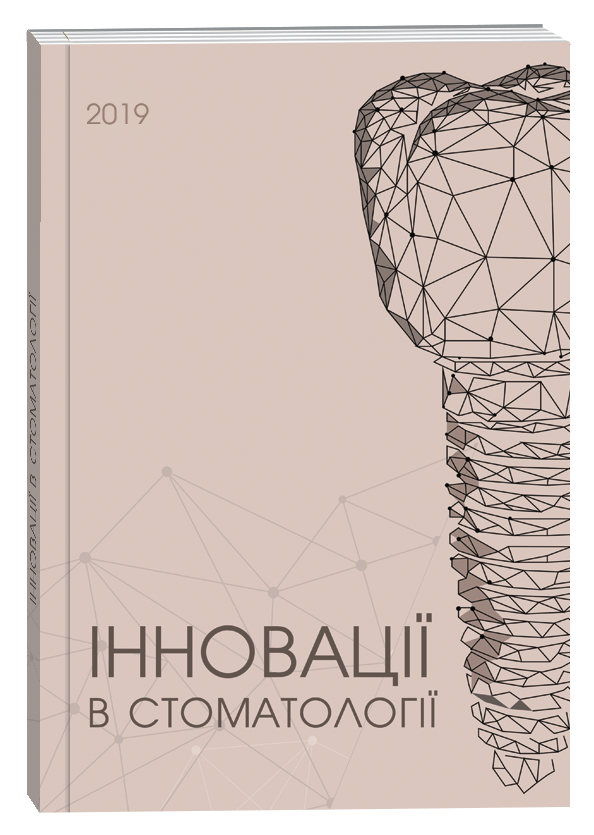FEATURES OF TREATMENT OF INTRAARTICULAR FUNCTIONAL DISORDERS OF THE TEMPOROMANDIBULAR JOINT USING OCCLUSAL CAPILLARY STRUCTURES
DOI:
https://doi.org/10.35220/2523-420X/2019.1.5Keywords:
joint, intraarticular functional disorders, occlusal captop structures, occlusive liningAbstract
The most common group of intraarticular functional disorders of the temporomandibular joint (TMG) is the bio-mechanical disorders of the complex "articular head - articular disk" with forward displacement of the articular disk. Clinical diagnostic criteria temporomandibular disorders (DC/TMD) allow to determine the presence of a pathology; instead, it is important for the physician to diagnose its causes in order to provide the most effective medical treatment. Orthopedic treatment using occlusal capstocks (occlusal splint therapy) is an important dental component in the treat-ment of intraarticular TMD. The choice of occlusal capstone structure, its therapeutic effect depends on the pathobiomechanical characteristics of functional disorders, the stage and severity of the pathological process, clinical symptoms and functional complications. Objective: To give a generalized description of the main occlusive capstocks for the treatment of intraarticular TMD. Results: the design features of occlusal drops depend on their functional pur-pose. In the case of intracapsular TMD, use relaxation-stabilizing occlusive canisters to stabilize the position of the mandible and normalize the activity of the masticatory muscles, repositioning kapi are used to establish the mandible in the therapeutic position with the normalization of the joints "head - disk - fossa". The immovable occlusive lining made of bisacrylic material allows you to permanently maintain the position of the lower jaw with the optimization of intra-articular interactions and eliminate excessive traumatic stresses on the TMG.
Conclusions. The use of occlusal capstone constructs (splint - therapy) to eliminate biomechanical manifestations of intracapsular TMD, such as articulation displacement, is an important component of therapeutic tactics and has shown a positive dynamics in the reduction of clinical manifestations, including inflammation and pain syndrome.
References
Molinari F., Manicone P.F., Rafaelli L., et al. Temporo-mandibular joint soft-tissue pathology, I: disk abnor-malities. Semin Ultrasound CT MR 2007; 28: 192-204.
Howard A. Israel Internal derangement of temporomandibular joint.New Perspectives on an old problem // Oral Maxillofacial Surg Clin N Am 2016. №28. - PP. 313–333. e-link: http://dx.doi.org/10.1016/j.coms.2016.03.009
Mehta N. The Merck manual of diagnosis and thera-py. In: Porter R., Kaplan J., editors. 19th edition. Whitehous Sta-tion (New Jersey): Merck Sharp end Dohme: 2011.
Ohrbach Richard Diagnostic Criteria for Temporomandibular Disorders Clinical Protocol and Assessment Instruments International RDC/TMD Consortium Network. - Version: 20 Jan. 2014. електронне посилання: http: // www.rdc-tmdinternational.org.
Schiffman Eric, Ohrbach Richard,Truelove Ed-mond, Look John et al Diagnostic Criteria for Temporomandibular Disorders (DC/TMD) for Clinical and RDC/TMD Consortium Network (International Association for Dental Research) and Orofacial PainSpecial Interest Group (In-ternational Association for the Study of Pain) // J Oral Facial Pain Headache. 2014; 28,1:6 – 27. e-link: https://www.ncbi.nlm.nih.gov/pubmed/24482784
Wilkes C.H. Internal derangements of the temporomandibular joint. Pathological variations. Arch Otolaryngol Head Neck Surg. 1989; Apr;115(4): 469-77. e-link: https://www.ncbi.nlm.nih.gov/pubmed/2923691.








